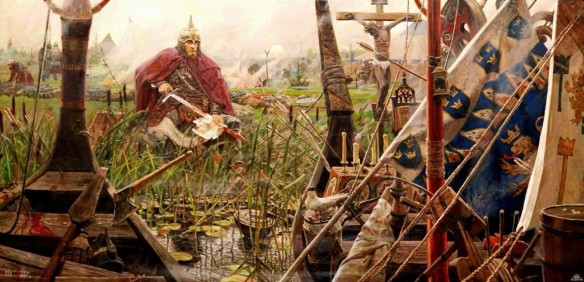
A battle at the river Neva in north-western Russia, fought on 15 July 1240.
The antecedents and details of this battle are largely hypothetical because they are known only from inadequate accounts in Russian sources. It has been supposed that the battle was connected with the Swedish military leader Birger Magnusson (d. 1266).
The Novgorod chronicle contemporary with the events states that Swedes, Norwegians, Finns, and Tavastians came by ship to the river Neva under the leadership of their prince and bishops. There they were defeated by Alexander Yaroslavich, prince of Novgorod, at the head of troops from Novgorod and Ladoga, and withdrew on their ships. According to the Vita of Prince Alexander the attacker was a “king of a Roman land” [Yurii K. Begunov, (Moskva: Nauka, 1965), pp. 162–168] and Alexander won with the help of an army of angels. One of the fifteenth-century sources gives the Swedish leader’s name as Belger.
From these sources it is not possible to identify the real leaders of the invasion. The view of older Finnish historiography, that the initiator of the campaign was the Finnish bishop Thomas (d. 1248), and the widespread opinion that the battle was a part of a greater attack against Russia are not valid. The sources do not connect the battle with either the crusade in Votia (1240–1241) or a Livonian campaign against Pskov (1240–1242). However, a papal letter to the archbishop of Uppsala in 1237 urged him to preach a crusade against the apostate Tavastians. It is thus possible that this crusade was led by Birger Magnusson in 1238–1239 and that the campaign to the Neva was a continuation of this expedition; at that time the Finnic peoples in the Neva basin were still heathen.
The battle has been especially celebrated in Russian historiography because Prince Alexander Yaroslavich has been honored in Russia as a saint and national hero in modern times. In Russian literature since the fifteenth century he has been known by the surname “Nevskii,” after this battle.
Bibliography Lind, John, “Early Russian-Swedish Rivalry: The Battle on the Neva in 1240 and Birger Magnusson’s Second Crusade to Tavastia,” Scandinavian Journal of History 16 (1991), 269–295. ———, “Bishop Thomas in Recent Historiography—Views and Sources,” in Suomen varhaiskeskiaika, ed. Kyösti Julku (Rovaniemi: Pohjois-Suomen Historiallinen Yhdistys, 1992), pp. 304–316. Nazarova, Evgeniya L., “The Crusades against Votians and Izhorians in the Thirteenth Century,” in Crusade and Conversion on the Baltic Frontier, 1150–1500, ed. Alan V. Murray (Aldershot, UK: Ashgate, 2001), pp. 177–195.